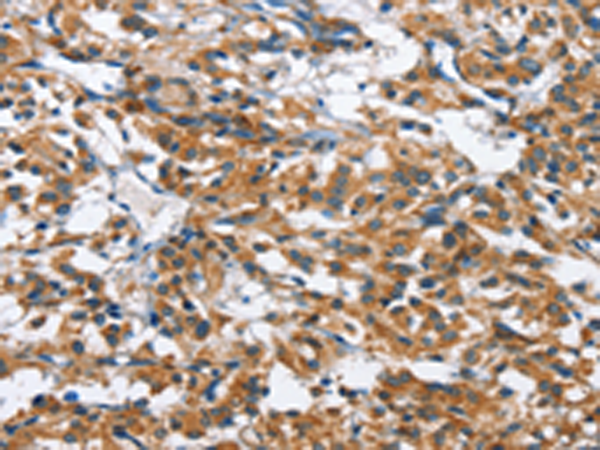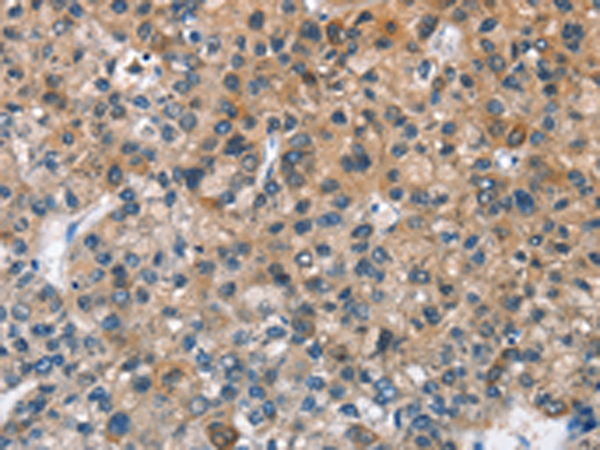

| WB | 咨询技术 | Human,Mouse,Rat |
| IF | 咨询技术 | Human,Mouse,Rat |
| IHC | 1/100-1/200 | Human,Mouse,Rat |
| ICC | 技术咨询 | Human,Mouse,Rat |
| FCM | 咨询技术 | Human,Mouse,Rat |
| Elisa | 咨询技术 | Human,Mouse,Rat |
| Aliases | rBPI; BPIFD1 |
| Host/Isotype | Rabbit IgG |
| Antibody Type | Primary antibody |
| Storage | Store at 4°C short term. Aliquot and store at -20°C long term. Avoid freeze/thaw cycles. |
| Species Reactivity | Human |
| Immunogen | Fusion protein of human BPI |
| Formulation | Purified antibody in PBS with 0.05% sodium azide and 50% glycerol. |
+ +
以下是3-4篇关于Histone H3(K79单/双/三甲基化)抗体的参考文献及其摘要概要:
---
1. **"Regulation of histone H3K79 methylation by Dot1L and its role in gene silencing"**
*作者:Trojer, D., & Reinberg, D. (2007)*
**摘要**:研究揭示了Dot1L酶催化H3K79单、双、三甲基化的机制,并利用特异性抗体证明H3K79me2/me3在异染色质形成和基因沉默中的关键作用,抗体验证了不同甲基化状态的功能差异。
---
2. **"Histone H3K79 methylation patterns in leukemia associated with MLL translocations"**
*作者:Okada, Y., et al. (2005)*
**摘要**:通过H3K79me1/me2/me3特异性抗体,发现MLL基因重排的白血病细胞中H3K79二甲基化水平显著升高,提示其异常甲基化与白血病发生相关,抗体用于染色质免疫沉淀(ChIP)分析。
---
3. **"DOT1L-mediated H3K79 methylation in DNA damage response"**
*作者:Fnu, S., et al. (2011)*
**摘要**:利用H3K79me2/me3抗体,证明DOT1L介导的甲基化参与DNA损伤修复过程,三甲基化修饰通过招募53BP1蛋白调控双链断裂修复,抗体特异性验证了修饰位点的功能。
---
4. **"Distinct roles of H3K79 methylation states in transcriptional elongation"**
*作者:Bernt, K.M., et al. (2011)*
**摘要**:结合ChIP-seq和H3K79me1/me2/me3抗体,发现不同甲基化状态在转录延伸中的作用:me1标记基因起始区,me2/me3富集于基因体,提示其调控Pol II进程的功能分层。
---
这些文献涵盖了H3K79甲基化在基因调控、疾病及DNA修复中的功能,并强调了特异性抗体在机制研究中的关键应用。
The Histone H3 (mono+di+trimethylK79) antibody is designed to detect methylation modifications at lysine 79 (K79) of histone H3. a post-translational modification linked to transcriptional regulation and chromatin dynamics. K79 methylation occurs in the globular core of H3. near the nucleosome’s DNA entry/exit site, and is catalyzed primarily by the methyltransferase DOT1L. Unlike many histone modifications localized to N-terminal tails, K79 methylation is situated within a structured region, influencing nucleosome stability and protein interactions. This modification exists in mono- (me1), di- (me2), or trimethylated (me3) states, each potentially associated with distinct chromatin states.
K79 methylation plays roles in transcription elongation, DNA repair, and replication. It is notably enriched in actively transcribed gene bodies and interacts with proteins involved in transcriptional machinery. Aberrant K79 methylation patterns are implicated in diseases, including leukemia, where DOT1L-mediated hypermethylation at K79 (particularly di/trimethylation) is linked to MLL gene rearrangement-driven oncogenesis. The Histone H3 (mono+di+trimethylK79) antibody is widely used in chromatin immunoprecipitation (ChIP), immunofluorescence, and Western blotting to study epigenetic regulation. Its ability to recognize all three methylation states makes it valuable for exploring dynamic changes in chromatin during development, differentiation, or disease progression. Specificity validation via knockout/knockdown models is recommended due to potential cross-reactivity with structurally similar epitopes.
×